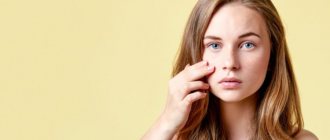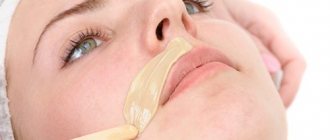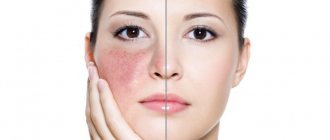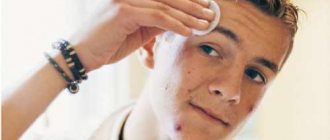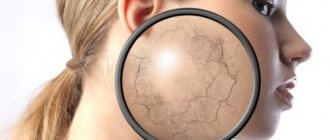Why do pimples* appear near the lips?
The appearance of acne in this area may indicate problems with the gastrointestinal tract and the need to cleanse the intestines. In addition to medicinal treatment of acne, you will also need to reconsider your diet, exclude fast food, carbonated drinks, reduce the amount of sweet and fatty foods, and do not rely on milk. The diet should be supplemented with fiber, consult a gastroenterologist about detox therapy.65
Treatment procedure using the M22 device
The treatment principle is based on the targeted action of light rays in the range of 311 nm. The phototherapy procedure is absolutely painless and safe, and at the same time very effective. There is no long recovery period required after it. Additional advantages are that one session only takes about 30 minutes, and the effect is targeted only to problem areas.
In addition to the treatment of comedones and acne, there is also photorejuvenation, pigmentation treatment, lifting, and also has an antiseptic effect. The necessary parameters are set on the device: wavelength and depth of exposure, radiation intensity, intervals between flashes and their duration. Before the procedure, the cosmetologist cleanses the skin, applies a conductive gel and protects the eyes of himself and the patient with special glasses.
The M22 hardware procedure is recommended not only for the treatment, but also for the prevention of acne.
Causes of acne on the bridge of the nose
Liver problems are reflected here. The culprits are alcohol and fatty foods. They are dangerous for the blood depot.65
If a rash appears in this area, you should pay more attention to your diet.65 You need to exclude flour, chocolate, smoked foods, fried foods, processed foods and fast food, and hot sauces.
One of the products that provoke acne is cow's milk. It contains active components that help increase testosterone levels in the blood and, as a result, activate the production of sebum. Therefore, such an acne provocateur will also have to be abandoned.
Chemical peeling
As mentioned above, light peelings can be carried out at home, however, more intense and, of course, effective chemical peels can only be carried out within the walls of a cosmetology clinic under the strict supervision of a cosmetologist to avoid skin burns. Chemical peeling exfoliates dead skin cells, tightens pores, and has an antiseptic and brightening effect.
Let's look at the most popular types of chemical peels.
Milk peeling is suitable for very sensitive skin. It can be done at any time of the year. Lactic acid is found in pickles and lactic acid fermentation products. In addition to it, the composition includes urea and a complex of amino acids. This peeling gently exfoliates and at the same time moisturizes the skin, and also stimulates the growth of new cells,
Almond can be on a gel or water-alcohol basis, and can also contain not only the main component (mandelic acid), but also other types of acids. Used to improve skin quality, regulate sebum production, reduce the appearance of wrinkles and age spots.
Azelaine peeling normalizes keratinization in the follicle ducts and sebum production, has an exfoliating, antibacterial and anti-inflammatory effect. It contains nonandioic, 1.7-heptanedicarboxylic acid, which is found in wheat, barley, lilac and other plants.
Glycolic and salicylic peels (AHA and BHA) are often performed simultaneously. In tandem, they have the maximum therapeutic effect: they not only cause the death of old cells, cause their desquamation, but also stimulate the production of natural collagen, as well as skin regeneration. They also discolor pigment spots and post-acne, improve metabolic processes.
What do pimples* on the nose mean?
Most often, pimples appear here as harbingers of puberty. Acne on the nose may indicate hormonal changes in the body.
But adult patients may also notice a rash on the nose, which indicates high cholesterol levels or problems with the cardiovascular system. But it is possible that the cause of blackheads should be sought in incorrectly selected cosmetics.
The use of comedogenic cosmetics often leads to clogging of pores and the progression of acne. An increase in the number of comedones, papules, and pustules is often a consequence of the use of alcohol-containing and overly aggressive cleansing components. They destroy the hydrolipidic layer of the skin, dry it out, as a result of which not only immunity decreases, but also the production of sebum is activated.
Let's look at the main types of comedones
Open comedones are the so-called blackheads. They are pores clogged with oxidized sebum and keratinized cells with melanin particles. Because of this, they have a dark shade and dense structure.
Closed comedones are small white subcutaneous nodules. They are formed when the sebaceous ducts are blocked by dead skin cells and sebum. Unlike blackheads, in closed comedones the plug is formed subcutaneously, and the duct does not have an exit to the outside. Papules quite often become inflamed, also cause pain, and a reddish tint appears around them.
Both types of comedones spoil the appearance, form irregularities, pigment spots, and depressions (as a consequence), and improper treatment and removal can cause the appearance of new lesions.
Many comedones form acne - a disease of skin rashes.
It is important not to confuse closed comedones with milia (epidermal cystic formations), sebaceous adenomas (benign skin formations characteristic of adulthood) and allergic rashes. Getting rid of these types of skin diseases is possible only in a beauty salon, under the supervision of a doctor.
Causes of acne in the periorbital area and on the cheeks
Patients often develop pimples* in the area around the eyes. This may indicate kidney disease, since this area is connected to the excretory system. But only a specialist can name the exact cause of acne in the eye area.65
The appearance of pimples* on the cheeks may indicate problems with the respiratory system. A rash on the cheekbones often appears in smokers and people prone to allergies.65
Facial rashes: how to control them
If you have ever suffered from acne, you will no longer be careless in choosing cosmetics. One word “comedogenic” and the cream is forgotten forever. Regular struggle with blackheads - closed comedones, but before dates or important meetings, as luck would have it, an unpleasant surprise always pops up, and on critical days, pimples are generally a common thing.
There are a lot of remedies in your arsenal: pharmacy, cosmetic, folk remedies, but none of them eliminates the symptoms once and for all. Your friends advise you to take nutritional supplements and go to the solarium; you are frantically looking for a sane cosmetologist who can prolong the unstable remission. Is acne really never going to be cured?
This is wrong. Acne can be treated quite successfully. If you have a severe or moderate form of the disease (“moderate” acne), consult a cosmetologist, preferably a cosmetologist-dermatologist. Now there are many professional anti-acne lines. Be prepared for long-term treatment with uneven dynamics: after 2-3 sessions, temporary deterioration is possible, but this does not mean that the therapy was chosen incorrectly. You may be offered a combination of external therapy and tablets.
Dermatologists' methods will be stricter. There is a protocol (systematically developed recommendations) for treatment - this is a combination therapy: external agents and tetracycline antibiotics for several months. In my opinion, this option should be chosen only in severe cases, when there are multiple inflamed pustules, cystic formations, nodes, etc.
If you are past this stage and just want to control your breakouts, read on.
On store shelves there are a lot of products for home care for acne-prone skin. Every cosmetic company – no matter whether it is large, professional or “organic” – produces natural, organic products and has a special line for problem skin. Let's figure out how not to get lost in the variety of anti-acne products.
The four most common myths about the composition of cosmetic products:
Myth No. 1: Cosmetics are safe if they are labeled “non-comedogenic” or “non-acnegenic.”
The label “non-comedogenic” means that the product does not provoke the appearance of non-inflammatory open or closed comedones, known as blackheads and bumps/irregularities of the skin.
The term “comedogenicity” is not confirmed by law; it was invented by marketers to make cosmetic lines for minimizing and controlling acne seem reasonable, that is, to increase sales. But still, if a developer makes statements about the “non-comedogenicity” of his product, he is obliged to somehow confirm them.
In the best case scenario, the manufacturer tests its composition on the backs of volunteers whose skin is prone to clogged pores. If a cosmetic product does not increase the number of comedones, it is labeled as “non-comedogenic.”
For me, this is a very questionable study, primarily because the sebaceous glands of different locations have an unequal number of receptors that increase the production of sebum, which leads to comedones. Nevertheless, even such tests are still a plus, since an attempt is made to at least somehow substantiate the result. Basically, manufacturers simply quote the List of Non-Comedogenic Substances created by Dr. Kligman (who discovered cosmeceuticals for us) back in 1979, that is, there are no tests, just a naked theory.
The situation with tests for “acnegenicity” is approximately the same - they are very conditional.
Therefore, labels should not be trusted 100%. Myth No. 2. Mineral oil is comedogenic.
Many people believe that blackheads appear on them precisely because of the mineral oil included in the cosmetic product.
It is found in every second product, especially often in decorative cosmetics. Such statements are based on research from many years ago. Today there are many mineral oils: industrial - for lubricating mechanisms, cosmetic - the purest, without any impurities for cosmetics. And if the first can be comedogenic, then the second is not. Myth No. 3. Sunscreens - sunscreens - provoke acne.
This is almost true. Almost, because if inflammation appears 24–48 hours after applying the product, it is not acne, but irritation caused by sunscreen elements, mainly UV filters.
Acne is an immune response. And it takes weeks to trigger a response from the immune system.
Myth #4: Large pores associated with acne can be erased with makeup.
Only if you use so-called grouts - silicone-based products, which, when applied to enlarged pores, fill and smooth out all unevenness. The effect of the grout is purely visual and lasts until the first wash.
The size of the pores depends on the development and activity of the sebaceous glands: children do not have them, because the glands are not yet developed, but then what grows, grows. As you age, the activity of the glands decreases; after 60 years, your pores will be smaller.
Retinoids (substances analogues of vitamin A), which reduce sebum regulation, and regular cleansing, which pushes out sebaceous plugs, will help bring the pores to a natural state, but hoping to reduce their size is foolish.
Principles of self-diagnosis
We often tend to dramatize the situation and be too critical of our skin. A couple of pimples after fatty/sweet/salty foods or menstruation cannot even be called acne by any stretch of the imagination, especially with oily or combination skin types.
If you have fewer than 20 white-headed blackheads, fewer than 15 pustules, and fewer than 30 lesions in total, you have “mild” acne. Treatment usually takes up to 8 weeks with external remedies.
If you have 20 to 100 whiteheads, 15 to 50 inflamed bumps, and 30 to 125 breakouts in total, you have “moderate” acne. Treatment also takes several weeks and may briefly worsen during the process.
Moderate acne and more severe situations require consultation and professional treatment.
The dangers of self-medication
There is a misconception that as soon as a pimple appears, it is necessary to immediately bring down all the power of modern medicine and cosmetology on it: dry it, squeeze it, cauterize it, etc. In this case, it should go away immediately. Meanwhile, the inflammation that has been quietly smoldering inside the hair follicles or sebaceous glands for several weeks, until the increased sulfur content provoked it to come out, simply cannot take and go away in minutes.
Mechanical damage to the skin, rubbing with chlohexidine, lotions with dimexide, essential oils can lead to ulcers, burns, secondary infection and further aggravate the situation.
Just remember that to fight inflammation, it's better to underdo it than overdo it. When interfering with the body today, you need to think about what will happen to it tomorrow and in 20 years. For example, overuse of drying agents will lead to early wrinkles. It is important to accept that a 100% positive result is not possible if you are predisposed to acne due to genetic or other reasons. Your skin has already been repeatedly damaged at the level of the dermis and hypodermis and, most likely, inflammation will appear in these places. Just control it.
What else is worth paying attention to
There are three common additional causes of inflammation in acne-prone people. In order to level or minimize them, experts advise following certain recommendations.
Progesterone
If inflammation occurs in the second phase of the cycle, calm down, the condition of the skin worsens during this period, as the hormone progesterone works. Wait for the calm phase and carry out treatment. Don’t panic that your products don’t work; don’t rush to urgently buy something “more effective.”
Errors in diet
“Overdose of spices” or carbohydrates. Over the past few years, doctors and scientists have been inclined to believe that there is a connection between diet and acne, although this was previously denied. An imbalance of intestinal microflora increases the permeability of the intestinal walls; the amount of bacterial endotoxins (toxic substances) inhabiting the intestinal lumen increases in the blood, which leads to acne.
Drink tomato juice - it contains lycopene (affects sebum production), eat carrots - they are rich in carotenoids (prevent oxidative stress), pumpkin seeds - contain tryptophan (affects melatonin), sea fish - rich in omega acids (acne sufferers lack such acids), fermented milk products are a source of probiotic cultures that normalize intestinal microflora.
Small subcutaneous white pimples - what are they?
A small white subcutaneous pimple is one of the manifestations of acne, popularly called “millet pimple” , since in appearance it is similar to a millet grain. A dense white nodule is called millet; such formations can occur either in the singular or in a fairly large cluster.
Typically, white pimples appear on the face, namely on the forehead, chin, cheeks, lower and upper eyelids, lips and nose, but can also occur on the chest, back, legs and neck.
Prevention
Realize that millet grains are a purely cosmetic defect; they do not pose a threat to your health and do not require immediate removal. However, if the rashes still cause discomfort, you should consult a dermatologist or cosmetologist for advice and treatment.
Prevention is as follows:
- As a treatment and prevention, you can use a special scrub that can be easily prepared at home . It is made from oatmeal. Grind it and then mix it with a teaspoon of salt and a teaspoon of soda. Before the procedure, thoroughly cleanse the skin, add a little foam to the prepared composition and apply the mixture to the skin with massage movements. After finishing the procedure, wash your face.
- A healthy lifestyle is also important. Reduce the amount of fried food in your diet, do not eat a lot of sweets and smoked foods. Then you will not only not have any wrinkles, but your figure and general health will also improve. Don't drink a lot of alcohol and carbonated drinks. Give up cigarettes. If you have stomach or intestinal diseases, contact a gastroenterologist and get rid of them.
- Salon procedures are also effective in preventing the appearance of millet grass . Facial cleansing of various types (vacuum, mechanical, etc.), as well as peelings, will cleanse the skin and prevent cysts from forming.
- To prevent wen from appearing on your face, protect your skin in the summer by staying in the sun for too long. Invest in sunscreen and a wide-brimmed hat.
Why should you see a doctor if you have cystic formations?
Treatment of severe acne can become more complicated due to the occurrence of acne elements of complex origin60:
- Phlegmonous. Confluences of large purplish-red pustules located in the deep layers of the dermis. They are characterized by a high rate of maturation and a tendency to form an abscess.
- Indurative. The result of the formation of a large infiltrate, which is located around the inflamed follicles. They have a bluish color. Such acne elements leave the most noticeable scars.
- Conglobate. Their appearance is also associated with the formation of infiltrate. Conglobate acne lies in the deep layers of the skin and is characterized by abscess formation. In addition to comedones, papules and pustules, many large nodes are formed; they are mainly located on the back and neck. The skin over them gradually becomes thinner, holes appear in it, from which pus comes out.
It is unrealistic to select effective drugs for therapy on your own. You should also be prepared for the fact that cystic acne can leave behind scars, which will have to be removed in a cosmetologist's office.
What are cysts?
A cyst is a pathological cavity in the tissues, which has dense walls and thick contents. The fusion of cysts and penetration into foci of infection leads to compaction of the formations, and sometimes to infiltration and abscess formation.
With cystic acne, areas of severe inflammation form. The cysts fill with pus, and pressing on them causes pain. Cystic elements are easily squeezed out, but this should not be done, as this can lead to tissue scarring.
Nodular cystic acne refers to a severe form of acne. Most often this happens if the disease is advanced and there was no timely treatment. The chronic inflammatory process provokes the formation of nodules with a diameter of more than 1 cm, which merge with cysts and other types of rash. In this case, the disease affects the deep layers of the dermis.
How to avoid comedones
- maintain hygiene , including regularly changing face towels and bed linen;
- avoid touching your face with your hands;
- normalize nutrition (avoid sweet, fatty, floury, fried foods and fast food), maintain a drinking regime, take vitamins;
- maintain a sleep schedule and try to avoid overwork and stress;
- do not neglect physical activity - this helps speed up metabolic processes, saturate cells with oxygen and remove toxins;
- to refuse from bad habits;
- use medications and medicinal products prescribed by a cosmetologist;
- monitor hormonal levels and avoid any changes;
- avoid prolonged exposure to the open sun;
- Do not self-medicate and do not use unproven methods of traditional medicine.
What to do if acne occurs?
To get rid of acne, you must first determine the true causes of the pathology. Before performing cosmetic procedures, experts advise visiting a dermatologist, endocrinologist, gastroenterologist and, of course, a gynecologist. Treatment of acne caused by gynecological or endocrine diseases includes eliminating the primary causes of the rash.
To help the body cope with acne faster, cosmetologists recommend reviewing your diet. Changing gastronomic habits (giving up sweets, flour, spicy, salty, etc.) can have a positive effect on the condition of the face.
Topical retinoids (adapalene)
In fact, this is the most important ointment for acne on the face. Topical retinoids are intended for external use. Such drugs are prescribed - 1) for the comedonal form of acne, which means acne, 2) for the papulopustular form of acne (i.e. in the presence of pimples). Previously, the topical retinoid tretinoin was used to treat acne, but it had a lot of side effects, and now there are much safer 4th generation topical retinoids, for example, adapalene.
Such drugs are monocomponent and combined. Monopreparations based on adapalene include Differin, Klenzit or Adaklin. A number of drugs of this type are produced only in the form of gels, but some manufacturers produce drugs with adapalene in both gel and cream form. Gel products will be more effective, but facial acne cream is more suitable for patients with dry and/or sensitive skin (and will help reduce the risk of irritation in such patients).
Examples of combination drugs with retinoids are 1) Klenzit-S, containing adapalene together with the antibiotic clindamycin, 2) Effezel, containing adapalene in combination with benzoyl peroxide. The choice of drug will depend on the severity of the acne, as well as on which inflammatory elements predominate in you (papules or pustules). All this information is schematically reflected in Table 1, which we placed before the description of groups of drugs for the treatment of acne.
How to treat facial acne with retinoids:
- Preparations containing adapalene should be used once a day before bedtime. Before applying a retinoid, you should wash your face with a mild cleanser. Before applying the retinoid, the skin must be completely dry, because... otherwise severe irritation will develop. To get your skin used to it and not be too irritated, start using the drug 3 times a week. After 1-2 weeks, switch to daily use.
When can you expect results: skin oiliness decreases sharply within a few days from the first use. As for acne and pimples, the first noticeable result can be seen only after about 4 weeks of therapy. Good results can be seen after about 8 weeks of using retinoids, but for radical improvement a full course is required, which lasts at least 12 weeks (3 months).
Use of oral retinoids:
In addition to topical retinoids intended for external use, there are also so-called systemic retinoids for oral administration. Such drugs (Acnecutane or Roaccutane) contain the retinoid isotretinoin. These drugs are very effective for treating acne, but they also have very serious side effects. Therefore, such drugs are used only in difficult situations, for example, for the treatment of nodular and conglobate forms of acne.
Use of oral contraceptives in women:
As for the use of oral contraceptives in women, you can read more about this method of treatment in the article at the link below:
→ Oral contraceptives for acne in women
How to properly care for skin with open and closed comedones
If the skin is prone to oiliness and the formation of closed and open comedones, it requires special care. Necessary:
- wash your face and use alcohol-free tonics and lotions containing acids;
- minimize the use of foundation and other cosmetic products that clog pores;
- do self-massage and tone the skin with contrasting washes and showers;
- use sunscreen cosmetics;
- monitor cell renewal, use home peelings and special brushes for washing, do not bring the skin to a critical condition;
- moisturize and nourish the skin from the outside to avoid drying and peeling. Restoring the water balance of the epidermis is extremely important for successful treatment;
- squeeze out pimples yourself
- regularly , undergo all prescribed procedures and follow recommendations.
